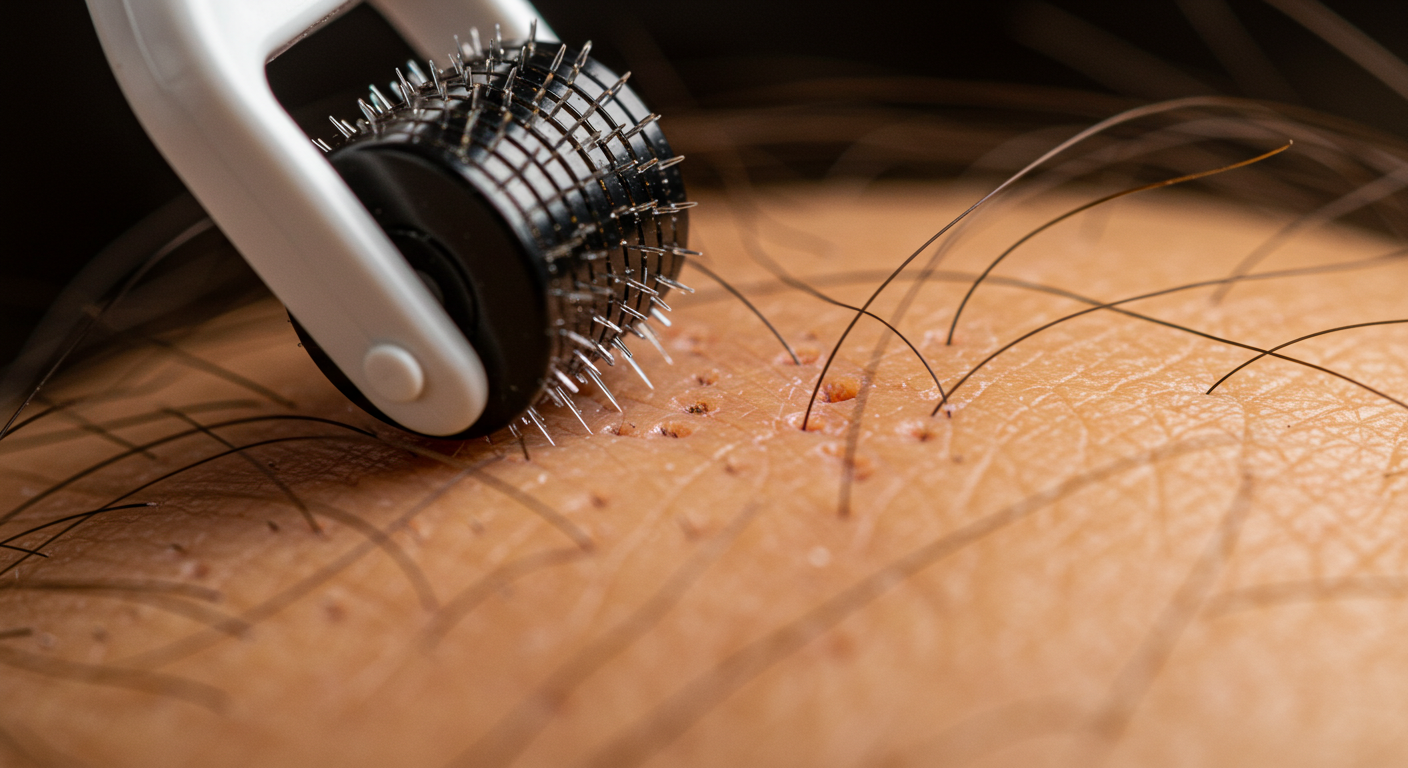Dr. Kumar’s Take:
A recent systematic review and meta-analysis highlights the potential of microneedling (MN) as an effective adjunctive treatment for androgenetic alopecia (AGA). The findings suggest that combining MN with conventional treatments like minoxidil, finasteride, or platelet-rich plasma (PRP) leads to superior hair density and diameter improvements compared to monotherapy alone. Moreover, the therapy appears to be well-tolerated with minimal adverse effects.
Brief Summary:
This study reviewed 13 randomized controlled trials (RCTs) involving 696 AGA patients to compare the effectiveness and safety of MN therapy combined with other treatments versus monotherapy. Results showed that combined MN therapy led to statistically significant improvements in hair density, hair diameter, and physician-reported efficacy compared to monotherapy. However, patient satisfaction ratings did not differ significantly between the groups. Safety outcomes revealed no significant difference in adverse effects between combined and single therapies.
Key Takeaways:
✔ Combined microneedling therapy significantly improves hair density and diameter compared to monotherapy.
✔ Physicians reported higher satisfaction with combined MN therapy, though patient satisfaction did not differ significantly.
✔ Adverse effects were minimal and comparable between combined and single therapies.
✔ Microneedling enhances drug penetration and stimulates follicle regeneration through the Wnt/β-catenin pathway.
✔ Further studies are needed to standardize microneedling parameters for optimal outcomes.
Study Design:
This meta-analysis included 13 RCTs with 696 participants aged 18–60 years diagnosed with AGA (Hamilton Norwood II-VII for men and Ludwig I-III for women). The interventions involved microneedling combined with minoxidil, PRP, finasteride, spironolactone, dutasteride, or fibroblast growth factor solutions. The control groups received single-agent therapy without microneedling. Treatment durations ranged from 2.5 to 6 months, with follow-up assessments.
Results:
✔ Hair Density Improvement: Patients undergoing combined MN therapy exhibited a significantly greater increase in hair density compared to those receiving monotherapy (MD = 18.11, 95% CI = [13.70, 22.52], p < 0.00001).
✔ Hair Diameter Increase: Combined MN therapy led to a significant increase in hair diameter compared to monotherapy (MD = 2.50, 95% CI = [0.99, 4.02], p = 0.001).
✔ Physician Satisfaction: The combined MN group received significantly higher physician-reported efficacy ratings than the monotherapy group (RR = 2.03, 95% CI = [1.62, 2.53], p < 0.00001).
✔ Patient Satisfaction: No significant differences were observed in patient-reported satisfaction (RR = 3.44, 95% CI = [0.67, 17.59], p = 0.14).
✔ Safety Profile: The incidence of adverse effects was comparable between groups (RR = 0.83, 95% CI = [0.62, 1.12], p = 0.22), with mild scalp irritation being the most reported issue.
How Microneedling Works for Hair Loss:
Microneedling promotes hair regrowth through multiple mechanisms:
- Enhancing Drug Absorption: MN creates microchannels in the skin, significantly improving the penetration of topical treatments like minoxidil and PRP.
- Activating Growth Pathways: MN stimulates the Wnt/β-catenin pathway, promoting hair follicle regeneration and increased expression of growth factors such as VEGF and PDGF.
- Microtrauma-Induced Stimulation: The controlled injury response triggers stem cell activation, improved follicular blood flow, and enhanced collagen production, which may reverse follicle miniaturization.
Related Studies and Research
Microneedling has gained attention as a promising treatment for hair loss. To see how it fits within the broader landscape of androgenetic alopecia solutions, check out:
- Androgenetic Alopecia Treatments: A Comprehensive Review – How microneedling compares to other treatment modalities.
- Low-Level Light Therapy: Enhancing Hair Growth with Photobiomodulation – Examining how red light therapy may complement microneedling.
- Minoxidil, Finasteride, and Dutasteride: A Scientific Comparison – Understanding how topical and oral medications interact with microneedling.
- Saw Palmetto for Hair Loss: A Natural Alternative – Evaluating non-invasive options for reducing hair follicle miniaturization.
Frequently Asked Questions:
How long does it take to see results with microneedling for hair growth?
Most studies observed significant improvements in hair density and diameter after 12–24 weeks of treatment.
Is microneedling painful?
The procedure causes mild discomfort but is generally well-tolerated. Most patients describe the sensation as tingling or minor irritation.
Can microneedling be done at home?
While some home-use microneedling devices exist, clinical-grade treatments performed by professionals offer superior results due to controlled depth and consistency.
How does microneedling compare to finasteride or minoxidil alone?
Microneedling enhances the efficacy of topical treatments like minoxidil and may serve as an alternative for individuals looking to avoid systemic side effects associated with oral finasteride.
Conclusion:
Microneedling represents a promising adjunctive therapy for androgenetic alopecia, particularly when combined with topical treatments like minoxidil. Its ability to enhance drug delivery while simultaneously stimulating natural growth factors makes it a valuable addition to the hair restoration toolkit. While more standardized protocols and larger studies are needed, current evidence supports microneedling as a safe, minimally invasive option that can significantly improve treatment outcomes for many patients with AGA.


